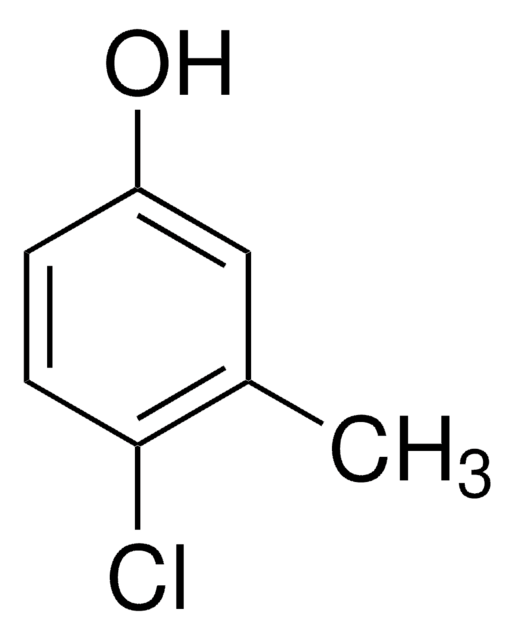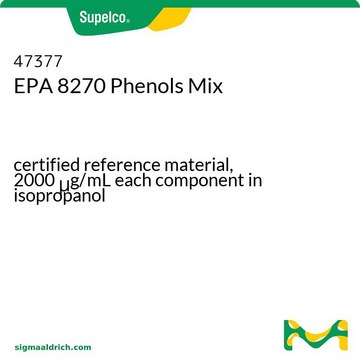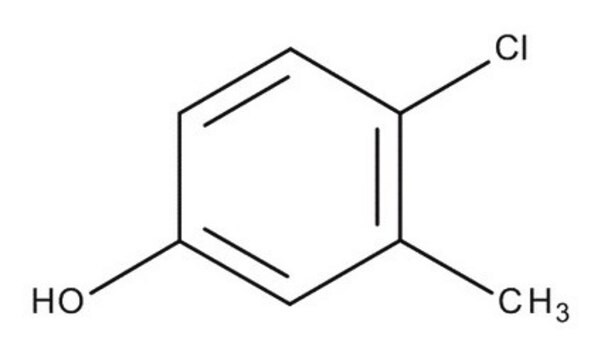おすすめの製品
詳細
4-Chloro-3-methylphenol is an organic compound belonging to the class of monochlorinated m-cresol. It is used as an organic building block in chemical synthesis.
アプリケーション
4-Chloro-3-methylphenol has been used in paint formulations.
シグナルワード
Danger
危険有害性情報
危険有害性の分類
Acute Tox. 4 Oral - Aquatic Acute 1 - Aquatic Chronic 3 - Eye Dam. 1 - Skin Corr. 1C - Skin Sens. 1B - STOT SE 3
ターゲットの組織
Respiratory system
保管分類コード
6.1A - Combustible acute toxic Cat. 1 and 2 / very toxic hazardous materials
WGK
WGK 2
引火点(°F)
244.4 °F - closed cup
引火点(℃)
118.0 °C - closed cup
個人用保護具 (PPE)
dust mask type N95 (US), Eyeshields, Faceshields, Gloves
適用法令
試験研究用途を考慮した関連法令を主に挙げております。化学物質以外については、一部の情報のみ提供しています。 製品を安全かつ合法的に使用することは、使用者の義務です。最新情報により修正される場合があります。WEBの反映には時間を要することがあるため、適宜SDSをご参照ください。
労働安全衛生法名称等を表示すべき危険物及び有害物
名称等を表示すべき危険物及び有害物
労働安全衛生法名称等を通知すべき危険物及び有害物
名称等を通知すべき危険物及び有害物
Jan Code
24940-BULK-F:
24940-1KG-F:
24940-VAR-F:
24940-250G-F:
24940-6X1KG-F:
A Peñalver et al.
Journal of chromatography. A, 839(1-2), 253-260 (1999-05-18)
Three pesticides usually added to paint formulations, Irgarol 1051, dichlofluanid and 4-chloro-3-methylphenol, were determined by solid-phase microextraction (SPME) with 85-micron polyacrylate fibers and gas chromatography-mass spectrometry. The parameters affecting the SPME process (the pH, the addition of salt to the
Quantitative measurement of Ca²(+) in the sarcoplasmic reticulum lumen of mammalian skeletal muscle.
Andrew P Ziman et al.
Biophysical journal, 99(8), 2705-2714 (2010-10-21)
Skeletal muscle stores Ca²(+) in the sarcoplasmic reticulum (SR) and releases it to initiate contraction, but the concentration of luminal Ca²(+) in the SR ([Ca²(+)](SR)) and the amount that is released by physiological or pharmacological stimulation has been difficult to
Ian McLaren et al.
Avian pathology : journal of the W.V.P.A, 40(1), 33-42 (2011-02-19)
Two experimental models of Salmonella contamination were used in an attempt to mimic the conditions of disinfectant use on farms. A wet model, for conditions such as boot dips, used disinfectant application to a slurry of poultry faeces inoculated with
Niels Ørtenblad et al.
The Journal of physiology, 589(Pt 3), 711-725 (2010-12-08)
Glucose is stored as glycogen in skeletal muscle. The importance of glycogen as a fuel during exercise has been recognized since the 1960s; however, little is known about the precise mechanism that relates skeletal muscle glycogen to muscle fatigue. We
C D Sanmartin et al.
Neuro-degenerative diseases, 10(1-4), 34-37 (2012-01-31)
Soluble amyloid-β peptide oligomers (AβOs), which are centrally involved in the pathogenesis of Alzheimer's disease, trigger Ca(2+) influx through N-methyl-D-aspartate receptors and stimulate reactive oxygen species generation in primary hippocampal neurons. We have previously reported that AβOs promote Ca(2+) release
ライフサイエンス、有機合成、材料科学、クロマトグラフィー、分析など、あらゆる分野の研究に経験のあるメンバーがおります。.
製品に関するお問い合わせはこちら(テクニカルサービス)









